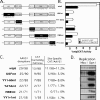Adeno-associated virus type 2 p5 promoter: a rep-regulated DNA switch element functioning in transcription, replication, and site-specific integration
- PMID: 17267512
- PMCID: PMC1866101
- DOI: 10.1128/JVI.02693-06
Adeno-associated virus type 2 p5 promoter: a rep-regulated DNA switch element functioning in transcription, replication, and site-specific integration
Abstract
The large Rep proteins, p68 and p78, function as master controllers of the adeno-associated virus type 2 (AAV2) life cycle, involved in transcriptional control, in latency, in rescue, and in viral DNA replication. The p5 promoter may be the nucleic acid complement to the large Rep proteins. It drives expression of the large Rep proteins, it undergoes autoregulation by Rep, it undergoes induction by helper virus, it is a target substrate for Rep-mediated site-specific integration (RMSSI), and it can function as a replicative origin. To better understand the relationship between each of the p5 functions, we have determined the effects of p5 promoter mutations (p5 integration efficiency element, or p5IEE) on transcription, integration, and replication using RMSSI transfection protocols in HeLa cells. The data demonstrate that the organization of the p5 promoter provides a unique platform for regulated AAV2 template transcription and subsequent repression by Rep through direct and indirect mechanisms. The elements of the p5IEE that define its function as a promoter also define its function as a highly optimized substrate for Rep-mediated site-specific integration and replication. The p5 Rep binding element (RBE) is essential in RMSSI and Rep-dependent replication; however, replacement of the p5 RBE with either the AAV2 inverted terminal repeat or the AAVS1 RBE sequence elements neither enhances nor severely compromises RMSSI activity of p5IEE. The RBE by itself or in combination with the YY1+1 initiator/terminal resolution sequence element does not mediate efficient site-specific integration. We found that replication and integration were highly sensitive to sequence manipulations of the p5 TATA/RBE/YY1+1 core structure in a manner that reflects the function of these elements in transcription. The data presented support a model where, depending on the state of the cell (Rep expression and helper virus influences), the p5IEE operates as a transcription/integration switch sequence element.
Figures






Similar articles
-
A 16bp Rep binding element is sufficient for mediating Rep-dependent integration into AAVS1.J Mol Biol. 2006 Apr 21;358(1):38-45. doi: 10.1016/j.jmb.2006.01.029. Epub 2006 Jan 30. J Mol Biol. 2006. PMID: 16516232
-
Functional differentiation between Rep-mediated site-specific integration and transcriptional repression of the adeno-associated viral p5 promoter.Hum Gene Ther. 2010 Jun;21(6):728-38. doi: 10.1089/hum.2009.192. Hum Gene Ther. 2010. PMID: 20070175
-
A genetic screen identifies a cellular regulator of adeno-associated virus.Proc Natl Acad Sci U S A. 2001 Dec 18;98(26):14991-6. doi: 10.1073/pnas.261567198. Epub 2001 Dec 4. Proc Natl Acad Sci U S A. 2001. PMID: 11734633 Free PMC article.
-
Bacteriophage Ø29 protein p6: an architectural protein involved in genome organization, replication and control of transcription.J Mol Recognit. 2004 Sep-Oct;17(5):390-6. doi: 10.1002/jmr.701. J Mol Recognit. 2004. PMID: 15362097 Review.
-
The roles of AAV Rep proteins in gene expression and targeted integration.Curr Top Microbiol Immunol. 1996;218:25-33. doi: 10.1007/978-3-642-80207-2_2. Curr Top Microbiol Immunol. 1996. PMID: 8794243 Review. No abstract available.
Cited by
-
High-throughput sequencing reveals principles of adeno-associated virus serotype 2 integration.J Virol. 2013 Aug;87(15):8559-68. doi: 10.1128/JVI.01135-13. Epub 2013 May 29. J Virol. 2013. PMID: 23720718 Free PMC article.
-
Relative influence of the adeno-associated virus (AAV) type 2 p5 element for recombinant AAV vector site-specific integration.J Virol. 2008 Mar;82(5):2590-3. doi: 10.1128/JVI.01956-07. Epub 2007 Dec 19. J Virol. 2008. PMID: 18094174 Free PMC article.
-
Harnessing the Natural Biology of Adeno-Associated Virus to Enhance the Efficacy of Cancer Gene Therapy.Viruses. 2021 Jun 23;13(7):1205. doi: 10.3390/v13071205. Viruses. 2021. PMID: 34201599 Free PMC article. Review.
-
Comprehensive mutagenesis maps the effect of all single-codon mutations in the AAV2 rep gene on AAV production.Elife. 2024 Mar 27;12:RP87730. doi: 10.7554/eLife.87730. Elife. 2024. PMID: 38536879 Free PMC article.
-
Efficiency and Specificity of Targeted Integration Mediated by the Adeno-Associated Virus Serotype 2 Rep 78 Protein.Hum Gene Ther Methods. 2018 Jun;29(3):135-145. doi: 10.1089/hgtb.2018.052. Hum Gene Ther Methods. 2018. PMID: 29860898 Free PMC article.
References
-
- Flotte, T. R., R. Solow, R. A. Owens, S. Afione, P. L. Zeitlin, and B. J. Carter. 1992. Gene expression from adeno-associated virus vectors in airway epithelial cells. Am. J. Respir. Cell Mol. Biol. 7:349-356. - PubMed
MeSH terms
Substances
LinkOut - more resources
Full Text Sources
Other Literature Sources
Miscellaneous

